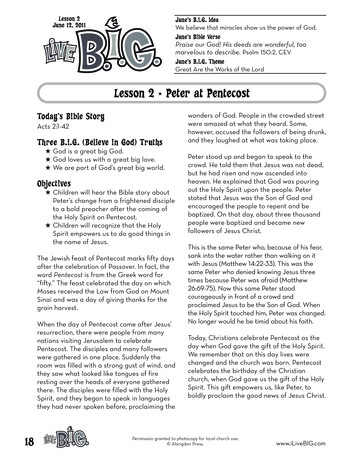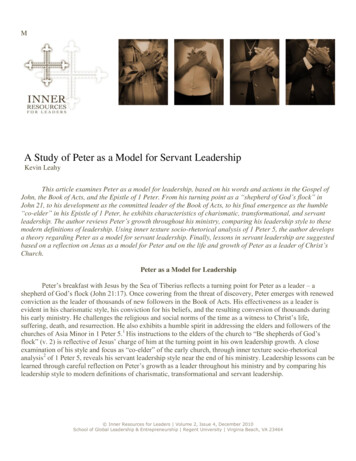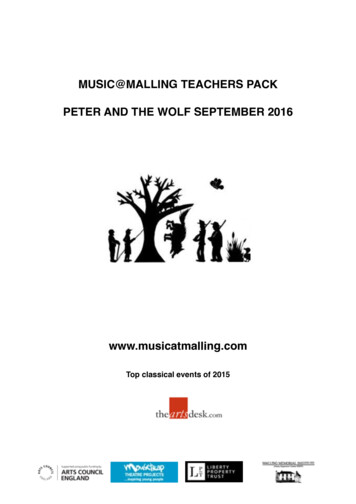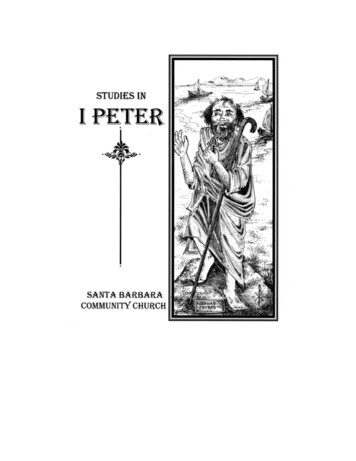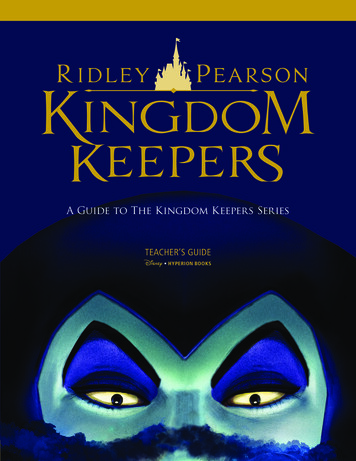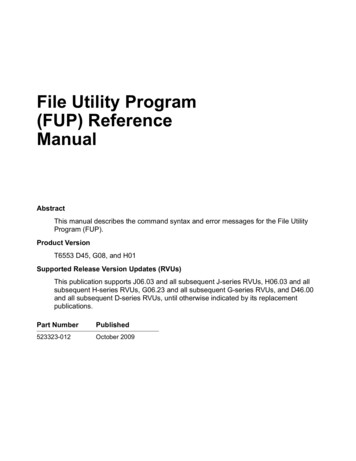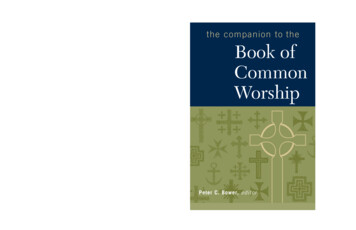
Transcription
the companion to theBook ofCommonWorshipPeter C. Bower, editor
Companion to the Book of--REV210/20/0410:13 AMPage iTHE COMPANION TO THEBOOK OF COMMON WORSHIP
Companion to the Book of--REV210/20/0410:14 AMPage iiiTHE COMPANION TO THEBOOK OF COMMON WORSHIPPETER C. BOWEREDITORGeneva PressLouisville, KentuckyOffice of Theology and WorshipPresbyterian Church (U.S.A.)
Companion to the Book of--REV210/20/0410:14 AMPage iv 2003 Office of Theology and Worship, Presbyterian Church (U.S.A.)All rights reserved. No part of this book may be reproduced or transmitted in any form or byany means, electronic or mechanical, including photocopying, recording, or by any information storage or retrieval system, without permission in writing from the publisher, except asnoted. For information, address Geneva Press, 100 Witherspoon Street, Louisville, Kentucky40202-1396.Brief portions of this Companion to the Book of Common Worship may be reproduced without special permission for a one-time use only, for worship and educational purposes, in anorder of service for use by a congregation, or in a special program or lesson resources, provided that no part of such reproduction is sold, directly or indirectly, and that the followingacknowledgment is included. Reprinted by permission from The Companion to the Book ofCommon Worship 2003 Office of Theology and Worship, Presbyterian Church (U.S.A.).Scripture quotations from the New Revised Standard Version of the Bible are copyright 1989by the Division of Christian Education of the National Council of the Churches of Christ in theU.S.A. and are used by permission.Book design by Sharon AdamsCover design by Night & Day DesignFirst editionPublished by Geneva PressLouisville, KentuckyThis book is printed on acid-free paper that meets the American National Standards InstituteZ39.48 standard.PRINTED IN THE UNITED STATES OF AMERICA03 04 05 06 07 08 09 10 11 12 — 10 9 8 7 6 5 4 3 2 1Library of Congress Cataloging-in-Publication DataThe companion to the Book of common worship / Peter C. Bower, editor.— 1st ed.p. cm.Includes bibliographical references and index.ISBN 0-664-50232-6 (alk. paper)1. Presbyterian Church (U.S.A.). Book of common worship (1993) 2. PresbyterianChurch (U.S.A.)—Liturgy. I. Bower, Peter C. II. Presbyterian Church (U.S.A.). Book of common worship (1993)BX8969.5 .C66 2003264'.05137—dc212002192711
Companion to the Book of--REV210/20/0410:14 AMPage vIn memory of Virginia Maudan undaunted leaderRemember “the words of King Lemuel.An oracle that his mother taught him:Speak out for those who cannot speak,for the rights of all the destitute.Speak out, judge righteously,defend the rights of the poor and needy.”PROVERBS 31:1, 8–9
Companion to the Book of--REV210/20/0410:14 AMPage viiContentsPREFACExiABBREVIATIONSxvPREPARATION FOR WORSHIP1THE SERVICE FOR THE LORD’S DAYConvictions about WorshipConvictions about the Service for the Lord’s DayOrigin and Development of the Fourfold Ordoof the Service for the Lord’s DayPurposes of the Ordo of the Service for the Lord’s DayCommentary on the Service for the Lord’s DayPreparing and Leading the Service for the Lord’s Day226RESOURCES FOR THE LITURGICAL YEARLiturgical TimeThe Shape of the Liturgical CalendarTexts Included in “Resources for the Liturgical Year”The Christmas Cycle: From the Darkness of the Worldto the Light of ChristChristmas: The Advent of the Messianic SaviorThe Day of Epiphany: Light to All PeopleAdvent: Come, Lord Jesus! Our Lord Has Come!Commentary on the Christmas Cycle (Advent—Christmas—Epiphany, January 6) ServicesAdventvii1419447282828488919193959898
Companion to the Book of--REV210/20/0410:14 AMPage viiiviii ContentsChristmas and EpiphanyThe Easter Cycle: From the Ashes of Death to the Fireof the SpiritEaster (Pascha): Celebrating the New OrderLent: The Way of the Cross to Easter (Pascha)Pentecost: Set on Fire as Witnesses to the Crucifiedand Risen ChristCommentary on the Easter Cycle (Lent—Easter—Day of Pentecost) ServicesAsh WednesdayPassion/Palm SundayMaundy ThursdayGood FridayThe Great Vigil of Easter: First Service of EasterEaster Sunday through Seventh Sunday of EasterAscension of the LordDay of PentecostOrdinary TimeTime between Epiphany and Lent, and Time betweenPentecost and AdventFestivals in Ordinary TimeThe Baptism of the LordThe Transfiguration of the LordTrinity SundayAll Saints’ Day (November 1)Christ the King (or Reign of Christ)Liturgical ColorBAPTISM AND REAFFIRMATION OF THE BAPTISMAL COVENANTRecovering the Meaning of BaptismObstacles to RecoveryReformed EmphasisPreparation for BaptismCommentary on the Baptism RitesThe Sacrament of Baptism: The Elements of the RiteAn Alternative Service for the Sacrament of BaptismBaptism and Reaffirmation of the Baptismal Covenant:A Combined 0
Companion to the Book of--REV210/20/0410:14 AMPage ixContentsixDAILY PRAYERThe Nature of Daily PrayerHours of Prayer and the Meaning of TimeHistory of Daily PrayerComponents of Daily PrayerThe Services of Daily Prayer ServiceMorning PrayerEvening Prayer (and Service of Light)Prayer at the Close of DayOther Services: Midday Prayer; Vigil of the Resurrection;Prayers at MealtimePreparing and Leading Daily Prayer173173176177179188189190191THE PSALMSSinging the Psalms202202PRAYERS FOR VARIOUS OCCASIONSThe Great LitanyOther LitaniesPrayers for Various OccasionsPrayers for the WorldPrayers for the Natural OrderPrayers for the Church and Other People of FaithPrayers for the National LifePrayers for the Social OrderPrayers for the Family and Personal LifePrayers for the Human ConditionA Variety of Uses208208209209209209210210210210210210CHRISTIAN MARRIAGEPastoral Challenge and Evangelical OpportunityCommentary on the Marriage RitesRite I: A Service for General UseRite II: A Service Based on the Service for the Lord’s DayRite III: A Service Recognizing a Civil MarriageSome Questions to Address in a Session Marriage PolicySuggestions for Conducting a Wedding Rehearsal212212221221229230230231191192
Companion to the Book of--REV2x10/20/0410:14 AMPage xContentsTHE FUNERAL: A SERVICE OF WITNESS TO THE RESURRECTIONBearing Witness to the ResurrectionComforting the BereavedArrangementsThe Funeral: A Service of Witness to the ResurrectionThe Committal ServiceSuggestions for a Service of Witness to the Resurrection234234235236237242244PASTORAL LITURGIESConvictions about Pastoral LiturgiesPastoral VisitsCommentary on Pastoral LiturgiesMinistry with the SickHoly Communion with Those Unable to Attend Public WorshipA Service for Wholeness for Use with a CongregationA Service for Wholeness for Use with an IndividualA Service of Repentance and Forgiveness forUse with a Penitent IndividualPrayer at the Time of Death246246249253253255260264BOOK OF OCCASIONAL SERVICESOrdination and InstallationCommissioningDedicationMarking Transitions in a CongregationMarking Transitions in a Governing BodyInterfaith ResourcesAdditional Prayers for Various Occasions266267270272276277277278APPENDIX A: GLOSSARY OF TERMS279APPENDIX B: FOR FURTHER READING287APPENDIX C: STUDY GUIDE for the Book of Common Worship295NOTES333ACKNOWLEDGMENTS338INDEX340264265
Companion to the Book of--REV210/20/0410:14 AMPage xiPrefacePurposeIn general, this Companion presents a variety of possibilities for enacting services in the Book of Common Worship (BCW) and, thereby, stimulates the imagination of worship planners and leaders in accomplishing their various tasks. Inparticular, this Companion provides background information regarding the services, comments on the rubrics accompanying texts, and suggests some ways touse the texts and, occasionally, abridge or augment them for particular situations.Role of the Directory for WorshipTo accomplish the above undertakings, this Companion necessarily alludes tostandards and emphases of the Directory for Worship which, since its inception in 1644, has highly influenced worship of English-speaking, Reformedchurches. Moreover, since 1788, the Directory has served as American Presbyterians’ constitutional basis for worship. The Directory is far more thansuggestive; it is part of and, therefore, on a par with the rest of the Book ofOrder. From a practical standpoint, the Directory functions as an applied theology handbook that prescribes and describes how things “shall, should, can,or may” be done in worship. The Directory, therefore, though void of liturgical text, serves as a primary planning resource for Presbyterians.Rather than quote “chapter and verse” from what is, in effect, a semperreformanda (“always being reformed”) Directory, this Companion draws onthe Directory’s ongoing standards thatpresent norms for the ordering and conduct of worshipcall for authentic and appropriate languagexi
Companion to the Book of--REV2xii10/20/0410:14 AMPage xiiPrefaceinvite expression of the faith through music and other artsencourage experiences of the fullness of psalmody through singingrejoice in the diversity of Presbyterian congregations particularly inenculturating various elements of worshipmandate appraisal of the fruit of worship in a congregation’s life and workencourage continuing reform of worshipcharge people to enact their ministries in their daily lifeIn short, a constant question before Presbyterian congregations is, In whatways does our corporate worship embody the directives set forth in the Directory for Worship?The Book of Common Worship (1993)A manifestation of the Directory for Worship is the Book of Common Worship(1993), which is the basic liturgical resource on which many worship planners draw and to which congregations are referred. Worship celebrations ofthe church’s long tradition, therefore, appropriate the BCW’s time-honoredfourfold structure or ordo:Gathering—The Word—The Eucharist or Thanksgiving—SendingThese encompass a sequence of elements: call to worship, hymn of praise,confession and pardon, prayer for illumination, reading and preaching of theWord of God, affirmation of faith, prayers of the people, Lord’s Supper orprayer of thanksgiving, hymn, charge and blessing. Every service is basicallythe same (in structure), yet every service is different (in mood, focus, content,and so on), because critical to every congregation’s worship is how such elements are celebrated for each service. Moreover, the elements of worship varyin texture according to occasion and time and place, both “in season and outof season” (for example, Christmas, Epiphany, Ash Wednesday, Good Friday,Easter, Pentecost, Sundays in Ordinary Time).Resources for Planning WorshipTo plan a service, one needs a Bible, Directory for Worship, Book of CommonWorship, and a hymnal such as The Presbyterian Hymnal: Hymns, Psalms,and Spiritual Songs; Come, Let Us Worship: The Korean-English Presbyterian Hymnal and Service Book; or El Himnario Presbiteriano. Other valuable
Companion to the Book of--REV210/20/0410:14 AMPage xiiiPreface xiiiresources include the Book of Occasional Services, Handbook to the RevisedCommon Lectionary, Holy Is the Lord: Music for Lord’s Day Worship, andThe Psalter: Psalms and Canticles for Singing.Those Who Shared in the Creation of This BookGiven that this Companion has drawn on all of the Supplemental LiturgicalResources (SLRs) published by the denomination during the years 1984–92,this present work represents the labor of a multitude of saints. To producethose resources, servants of Christ’s church met in seven different task forcesfor several years shaping the form and substance of the church’s liturgieswhich, several years later, developed into the actual services in the Book ofCommon Worship. The names of these devoted contributors who paved theway for the Book of Common Worship are printed in that work (pp. 10–11).The task of appropriating those past Resources and blending them withcurrent scholarship and practice so as to create this Companion was embracedby four persons who served as principal writers for the following areas:Mary Beth Anton, Chaplain of Trinity School, Midland, Texas—PastoralLiturgies and Book of Occasional ServicesPeter C. Bower, Interim Pastor of Appleby Manor Memorial Presbyterian Church, Ford City, Pennsylvania—Resources for the LiturgicalYear, Daily Prayer, Singing the Psalms, Study Guide, Glossary ofTerms, For Further Reading, and IndexRon Byars, Professor of Preaching and Worship, Union TheologicalSeminary–Presbyterian School of Christian Education, Richmond,Virginia—The Service for the Lord’s Day and Prayers for VariousOccasionsBrant S. Copeland, Pastor of First Presbyterian Church, Tallahassee,Florida—Baptism and the Reaffirmation of the Baptismal Covenant,Christian Marriage, and The Funeral: A Service of Witness to the ResurrectionThese four persons were ably assisted by denominational staff whose oversight of the project as well as personal commitment to its realization was constant from start to finish. Their insights and encouragement are especiallytreasured:Alan Barthel, Executive Director of the Presbyterian Association of Musicians (PAM), Presbyterian Church (U.S.A.), Louisville, Kentucky
Companion to the Book of--REV210/20/0410:14 AMPage xivxiv PrefaceMartha Moore-Keish, Associate for Worship, Office of Theology andWorship, Presbyterian Church (U.S.A.), Louisville, KentuckyJoseph D. Small, III, Associate Director of Theology, Worship, and Discipleship, and Coordinator of the Office of Theology and Worship,Presbyterian Church (U.S.A.), Louisville, KentuckySpecial gratitude is due to Horace T. Allen Jr. and Harold M. Daniels, bothformer leaders of the Office of Worship in the Presbyterian Church (U.S.A.),who painstakingly examined every page and paragraph and sentence, offering numerous helpful suggestions. Their singular gifts and experiences havegreatly enhanced this resource for the church’s use. Words cannot express thedepth of appreciation for both of these saints, but all of us are blessed by theirdedication.Many, many thanks are extended to reviewers who freely gave of themselves to critique portions or even entire drafts of the text. Their additions,corrections, and deletions were both needed and welcomed. Reviewersinclude: John E. Ambrose, Rubén P. Armendáriz, David B. Batchelder, Donald A. Busarow, Carole J. Carter, Melva Wilson Costen, Carol Doran, DonaldP. Ely, Arlo D. Duba, Patricia M. Fort, Paul H. Galbreath, Jane Parker Huber,W. Ben Lane, Cynthia Weeks Logan, Adele Dieckmann McKee, John W.Neely Jr., David C. Partington, Richard M. Peek, David H. Pfleiderer, JaneRogers Vann, John Weaver, Mina Belle Packer Wichmann (also proofreaderpar excellence), Janet Wolfe, Helen Wright, and the Worship Committee ofPebble Hill Presbyterian Church, Dewitt, New York.All of the above saints spiritedly embrace the following words writtennearly a century ago in the Book of Common Worship, 1906:Concerning the Use of This Book: None of the Forms of Service in thisBook are intended to be in any sense obligatory; but where a given Orderis voluntarily used it will promote unity. (BCW 1906 vii)Amen!Soli Deo gloria (“To God alone be glory!”)—PETER C. BOWER
Companion to the Book of--REV210/20/0410:14 AMPage xvAbbreviationsBCWBook of Common Worship. Louisville, Ky.: Westminster/JohnKnox Press, 1993.BCW-DPBook of Common Worship: Daily Prayer. Louisville, Ky.: Westminster/John Knox Press, 1993 (pocket-sized edition of theDaily Prayer section of BCW 489–837, 1049–1097).BOSBook of Occasional Services. Louisville, Ky.: Westminster JohnKnox Press, 1999.HBThe Hymnbook. Philadelphia: Presbyterian Church in theU.S.A., 1955.HBRCLPeter C. Bower. Handbook to the Revised Common Lectionary.Louisville, Ky.: Westminster John Knox Press, 1996.HLHoly Is the Lord: Music for Lord’s Day Worship. Louisville,Ky.: Geneva Press, 2002.HPEl Himnario Presbiteriano. Louisville, Ky.: Westminster JohnKnox Press, 1999.K-ECome, Let Us Worship: The Korean-English Presbyterian Hymnal and Service Book. Louisville, Ky.: Geneva Press, 2001.PHThe Presbyterian Hymnal: Hymns, Psalms, and SpiritualSongs. Louisville, Ky.: Westminster/John Knox Press, 1990.PSThe Psalter: Psalms and Canticles for Singing. Louisville, Ky.:Westminster/John Knox Press, 1993.RCLConsultation on Common Texts. The Revised Common Lectionary: Includes Complete List of Lectures for Years A, B, andxv
Companion to the Book of--REV210/20/0410:14 AMPage xvixvi AbbreviationsC. Nashville: Abingdon Press, 1992 [included in BCW,1035–1048].WBThe Worshipbook—Services and Hymns. Philadelphia: Westminster Press, 1972.
Companion to the Book of--REV210/20/0410:14 AMPage 1Preparation for Worship(BCW 15)Prayers for Use before Worship (BCW 17–30)Nearly a century ago, the Book of Common Worship, 1906, succinctly yet profoundly described the essence of not only this section but the entire book:We have searched the Holy Scriptures, the usage of the ReformedChurches, and the devotional treasures of early Christianity, for the mostnoble, clear, and loving expressions of the Spirit of Praise and Prayer; andwe have added to these ancient and venerable forms and models, such others as might serve, under the guidance of the Spirit, to give a voice to thepresent needs, the urgent desires, and the vital hopes of the Church livingin these latter days and in the freedom of this Republic. (BCW, 1906, iv–v)The same can be affirmed regarding liturgical texts throughout the Book ofCommon Worship, 1993. Prayers for Illumination (BCW 60, 90–91), Prayersof the People (BCW 99–124), Great Thanksgivings (BCW 126–156), Prayersfor Various Occasions (BCW 785–837; BCW-DP 391–455), and otherprayers represent ancient and venerable forms and models and also give voiceto the present needs, urgent desires, and vital hopes of the church.1
Companion to the Book of--REV210/20/0410:14 AMPage 2The Service for the Lord’s Day(BCW 31–161)Convictions about WorshipWorship: Why? Who? What? When? Where? How?Building Up the ChurchAn elderly woman, having lost her hearing and most of her sight, continued torequest a ride to church every Sunday morning. A friend asked her why she bothered, since she could not hear the sermon, the prayers, or the music. She replied,“I go to show whose side I’m on.” Sometimes it is as simple as that. In a societythat is home to people of both no faith and faith in every sort of deity, we standto be counted, at least once a week, among the congregation of Jesus Christ.Sometimes we go to church in search of something. We hope for a word ofencouragement, a word of healing, some support for our flagging hope. Or wego because our faith is at high tide, and we are brimful of the need to celebrate that faith. We go to be supported by others, or to be a support—and, then,in another week or two, when things have shifted, we trade roles. A case canbe made for going to worship to support and encourage one another and to“build up” the church (1 Cor. 14:4).Some of us learned why we worship from the answer we recited in theShorter Catechism: the very purpose of human life is “to glorify God,” and“enjoy” God, forever (First Question and Answer, Westminster Shorter Catechism, The Book of Confessions; Louisville, Ky: Office of the General Assembly, Presbyterian Church (U.S.A.)). There is something about glorifying andenjoying God that makes it require company, a community, sharing an act.According to the witness of the New Testament, to be a Christian is to be partof a people: “For in the one Spirit we were all baptized into one body” (1 Cor.12:13). Christianity simply is not a solitary affair. And, “because there is onebread, we who are many are one body” (1 Cor. 10:17).2
Companion to the Book of--REV210/20/0410:14 AMPage 3The Service for the Lord’s Day3Royal PriesthoodWhatever personal reasons lead us to church, another reason, whether we areaware of it or not, invites our attention. God has called the church to assemble and offer its service as a corporate priesthood. Scripture puts it like this:“But you are a chosen race, a royal priesthood, a holy nation, God’s own people.” Chosen for what? God’s own people for what? “In order that you mayproclaim the mighty acts of him who called you out of darkness into his marvelous light” (1 Pet. 2:9).As a “royal priesthood,” we gather weekly to worship God and to pray notonly for ourselves but for this entire broken world. We pray for those whobelieve and for those who do not believe; for those who pray for themselvesand for those who do not or cannot pray; for those who love God and for thosewho are indifferent or even hostile to God. We pray for our enemies, for thosewho have set themselves against us and against Christ’s church (Matt.5:43–48). That is our priesthood, in which the Christian church persists in themission first given to the descendants of Abraham and Sarah: to be a blessingto “all the families of the earth” (Gen. 12:3).Forming WorshipWhenever and wherever a people gather for worship, the service has someform. Even a silent Quaker meeting has a form. The most informal prayermeeting has a form. The question is not whether there ought to be some formto a gathering for worship, but how to shape that form. The worship of theearliest Christian churches formed around two poles: the reading and preaching of Scripture, and the covenant meal, the Lord’s Supper.WordSacramentLuke’s story of the travelers on the road to Emmaus displays both foci ofWord and Meal when it says that, as Jesus sat at table with the travelers, “theireyes were opened, and they recognized him” (Luke 24:31); and, as they
Companion to the Book of--REV2410/20/0410:14 AMPage 4The Companion to the Book of Common Worshipreflected on their conversation with him on the road, they asked each other,“Were not our hearts burning within us while he was talking to us on the road,while he was opening the scriptures to us?” (Luke 24:32). However muchgatherings for worship may have varied from place to place, it seems evidentthat they were shaped by a form that embraced both Word and Meal. Forinstance, all four Gospels, notes liturgical scholar Gordon Lathrop, “followexactly the same shape: baptism, narratives, meal and passion, resurrection,and sending. Such a list is, in exactly this order, recognizable to us as theemerging shape of the Christian Sunday meeting.”1Gospel-Shaped WorshipTwentieth-century scholarship undertaken by representatives from allbranches of the church has led us to rediscover how Christian worshipbegan to form a relatively consistent shape at least as early as the secondcentury. That shape resembles that of the Gospels, as Lathrop has noted:Scripture and preaching, Lord’s Supper with its commemoration of JesusChrist crucified and risen, and sending out the congregation with a chargeand a blessing. As a result of these scholarly investigations, a remarkableecumenical consensus has formed among students of worship in manydenominations and confessional bodies. Whereas some Roman Catholicshave complained that their services are becoming “too Protestant,” andsome Protestants have complained that their services are becoming “tooCatholic,” the truth is that both have been influenced more by the resultsof twentieth-century research than by directly imitating one another. Boththe current Directory for Worship of the Presbyterian Church (U.S.A.) and“The Service for the Lord’s Day” are fruits of the ecumenical consensus.While they exhibit some of the characteristic marks of the Reformed tradition, they also recover a heritage from a time before a Catholic/Protestantdivide could even be conceived. This heritage is rightfully ours just as it isalso the legacy of other Christians.Our Prayer and the Prayer of the Whole ChurchAn instructive paragraph in the Preface to the Book of Common Worshipstates:Local pastoral concerns will determine the appropriate way to use the textsand services.Some will find strength and a sense of unity in the prayers shared in common with the whole church and so will use the liturgical texts as theyappear in this book.
Companion to the Book of--REV210/20/0410:14 AMPage 5The Service for the Lord’s Day5Others will find it more appropriate to adapt the prayers for use in a particular setting.Others will be prompted to follow the structure of the services as theyare outlined and use the texts as models for a free and spontaneousstyle of prayer.Each of these styles is appropriate within the provisions of the directoriesfor worship, and it is the intent of the Book of Common Worship to providethe necessary resources (BCW 6–7).That is to say, employ the Book of Common Worship in the way mostappropriate to a particular congregation. In shaping the liturgy, however, takeseriously the Book of Common Worship’s ordo (Latin, “order,” “structure,”“shape,” “pattern”) concerning the overall structure of services as well as theform and function of specific texts, such as the eucharistic prayer. The Bookof Common Worship does not provide liturgical recipes among a smorgasbord of worship cookbooks from which to select a morsel or two for a service, but it presents a resource of texts that fit within and give expression toa certain shape or ordo. Texts drawn from a worship resource pressing a particular agenda or from well-intentioned but inconsistent “homemade” materials may lead to confusing, tenuous, or contradictory content or tone. Awell-crafted, poetic eucharistic prayer may miss the mark of a eucharisticprayer’s form and function. In short, in planning liturgy, take care both toknow and to give expression to the ordo that the Book of Common Worshipembraces. Knowing the ordo (both the ordering and the nature of particularprayers) of the liturgy both precedes and permits freedom. In this manner,the Book of Common Worship can offer an instrument to help plan a liturgyin which worshipers can recognize the prayer of the whole ecumenicalchurch while at the same time know themselves to be worshipers in and of aparticular time and place.No congregation is expected to conform slavishly to the Book ofCommon Worship, indifferent to the local context, as though the purpose ofthe liturgy is to speak and sing all the right words in the proper order. Onthe other hand, attempts to reinvent the liturgy every week almost certainlywill lead to failure and disappointment. What is critical is the shape of theliturgy, both its order and its texts. Grounded in this liturgical bedrock, theBook of Common Worship invites each of the above styles: using the textsand services “as is,” adapting the liturgical texts for use in a particularsetting, or following the structure of the services and using the texts asmodels.
Companion to the Book of--REV2610/20/0410:14 AMPage 6The Companion to the Book of Common WorshipConvictions about the Service for the Lord’s Day“The Service for the Lord’s Day,” reflecting both the ecumenical consensusand the experience of the Reformed churches, is based on several convictions.1. Liturgy and LifeUse-less WorshipFrom a certain point of view, worship is use-less. It may be, of course, thatpeople have found worship to be useful. It may have been useful in reducingstress; in developing closer ties to family members, friends, and evenstrangers; in introducing us to a deeper appreciation for Scripture and to thedoctrines of the church; in making contacts that proved to be fruitful personally or professionally. However useful worship may have proved to be, thechurch does not gather to worship as a strategy to achieve some useful end.Worship is, first and foremost, a people’s meeting with the God who hastaken the initiative to gather that people. It is a gathering intended for no otherpurpose than to offer our praise, our thanksgiving, and our lament, while trusting the Spirit to bring us into the presence of the risen Christ. It is not adulteducation. It is not socializing. It is not therapy. It is not networking. It is nota rally to support programs or causes. For all practical purposes, it is andought to be use-less. (See Marva J. Dawn, A Royal “Waste” of Time: TheSplendor of Worshiping God and Being Church for the World; Grand Rapids:Wm. B. Eerdmans Publishing Co., 1999.)Worship Shapes Particular Kinds of CommunitiesNevertheless, to be use-less does not mean to be divorced from life. The consistent discipline of the church’s worship shapes a particular kind of community. The Word of grace read and preached shapes graciousness in acongregation. Praying for others shapes people’s sensibilities and can alsoshape the ways a congregation orients itself to each other and to the world.Offering praise and thanksgiving shapes the living of a thanks-filled life.Invited to gather at the Lord’s Table, we glimpse the reconciled humanity thatGod intends, where people come from all points of the compass in peace(Luke 13:29), none dominating the others, all made strong in the same nourishing Spirit. If this image of a reconciled humanity is to be made clear, ourworship will be at its best when it includes children—particularly baptizedchildren, who become members of the church at baptism, as the Reformed tradition has affirmed, and American Directories for Worship have testified.Moreover, “membership in the faithful assembly knows no criteria of age,
Companion to the Book of--REV210/20/0410:14 AMPage 7The Service for the Lord’s Day7weight, education, or intelligence quotient—only those of faithful initiationinto Christ in his Church.” 2The Directory for Worship realizes this conviction underlying “The Servicefor the Lord’s Day” when it links worship with God’s call to the church torespond to God’s grace by joining Christ’s mission in the world. As Jesuswashed the disciples’ feet in the upper room, in worship he also equips us withtowel and basin to extend our ministry to those weary from their journey. Whenwe leave worship, we leave with both a charge and a blessing. The last wordsof the liturgy send us out to where we will once again find “all
Rite I: A Service for General Use 221 Rite II: A Service Based on the Service for the Lord's Day 229 Rite III: A Service Recognizing a Civil Marriage 230 Some Questions to Address in a Session Marriage Policy230 Suggestions for Conducting a Wedding Rehearsal231 Contents ix Companion to the Book of--REV2 10/20/04 10:14 AM Page ix
![INDEX [gfgenealogy ]](/img/44/index-to-wills-cascade-county.jpg)
